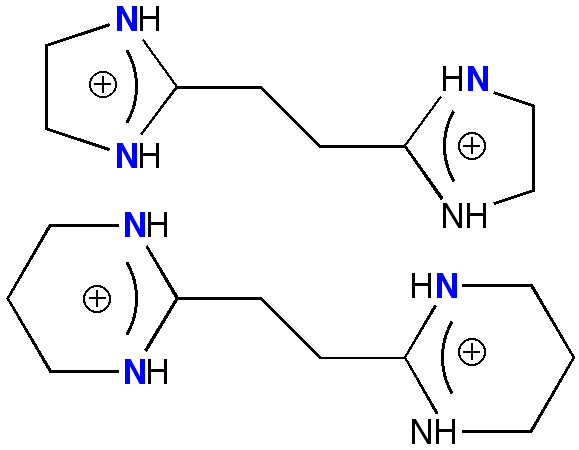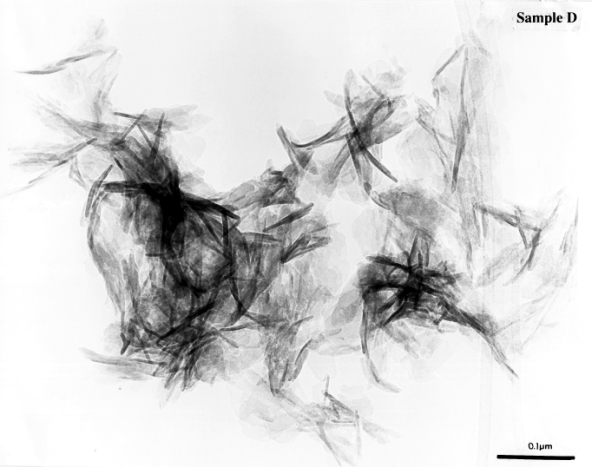Résumés Année 2003
"A molecular tectonics/crystal enginering approach for building organic/inorganic composites. Potential application to the growth control of hydroxyapatite crystals"
J.-M. PLANEIX, W. JAUNKY, T. DUHOO, J. CZERNUSZKA, M. W. HOSSEINI, E. F. BRES, J. Mat. Chem., 2003, 13, 2521-2524.(download .pdf)
Abstract: A molecular tectonics approach was used for processing organic/hydroxyapatite composites, preliminary results concerning the growth control of hydroxyapatite (HAP) nanocrystals are presented.
 |  |  |
"Molecular tectonics : Design of enantiomerically pure single-stranded helical H-bonded molecular networks"
P. GROSSHANS, A. JOUAITI, V. BULACH, J.-M. PLANEIX, M. W. HOSSEINI, J.-F. NICOUD, Cryst. Eng. Comm., 2003, 5, 414-416.( download .pdf )
Abstract: The self-assembly between self-complementary tectons based on the enantiomerically pure isomannide stereoisomer bearing both H-bond donor (OH group) and acceptor (pyridine unit) groups generates analogous enantiomerically pure single-stranded helical infinite H-bonded networks which were structurally characterised by X-ray diffraction studies on single crystals.
 |  |  |
"Molecular tectonics : design of coordinating tectons based on fluorene bearing pyridines and structural analysis of their coordination networks generated in the presence of mercury and cobalt salts"
P. GROSSHANS, A. JOUAITI, N. KARDOUH, M. W. HOSSEINI, N. KYRITSAKAS, New J. Chemistry, 2003, 27, 1806-1810.( download .pdf )
Abstract: A series of six new bis-monodentate tectons based fluorene skeleton and bearing two pyridine derivatives as coordinating sites have been designed and prepared. The ability of two of them presenting a "V" type geometry to generate coordination networks in the presence of HgCl2 or CoCl2 acting as metallatectons and offering either a "V" or a square type geometry respectively was structurally studied by X-ray diffraction on single crystals. Whereas a combination of "V" shape organic and metallic tectons leads to a 1-D coordination network, when combining a "V" shape organic tecton with a metallatecton presenting four available coordination sites occupying the corners of a square, a 2-D neutral coordination network was obtained. In the latter case, a two-fold homo interpenetrating architecture was obtained.
 |  |  |
"Molecular tectonics : structural and magnetic properties of a discrete Copper binuclear complex and a 1-D coordination network"
S. FERLAY, A. JOUAITI, M. LOÏ, M. W. HOSSEINI, A. DE CIAN, P. TUREK, New J. Chemistry, 2003, 27, 1801-1805.( download .pdf )
Abstract: The two new copper complexes 2 ([Cu2(pyS4)Cl4]. 2CHCl3) and 3 ([Cu2(pyS4)Cl2]2+. 2BF4-) have been prepared, their crystal structure elucidated and their magnetic properties have been studied. The compound 2 is a discrete binuclear copper (II) complex (monoclinic, P 21/n space group, Z = 2, a = 9.7076(3)Å, b = 12.6420(3)Å, c = 16.1419(3) and b = 98.468(2)°. The geometry around the metal centre is a distorted square pyramid. The compound 3, in contrast, is an infinite coordination network formed upon mutual bridging of binuclear species through chloride atoms (monoclinic, C2/c space group, Z = 4, a = 32.475(3)Å, b = 13.496(2)Å, c = 8.7380(5) and b = 96.335(6)). Again, the geometry around each copper atom is closed to a square pyramid. The packing of the 1-D coordination networks generates channels which are occupied by BF4- anions. The magnetic behaviour observed for the 1-D network is comparable to the one corresponding to a discrete chloro-bridged copper (II) binuclear complex. In terms of magnetic coupling, whereas a strong ferromagnetic coupling is observed between the two spin bearers within the dimer (d = 3.467Å) (J/kB = 337 K), a weak interdimer antiferromagnetic interaction is measured (zJ’/kB =-1.6 K).
 |  |  |
"Molecular tectonics: from enantiomerically pure sugars to enantiomerically pure triple stranded helical coordination network"
P. GROSSHANS, A. JOUAITI, V. BULACH, J.-M. PLANEIX, M. W. HOSSEINI, J.-F. NICOUD, J. Chem. Soc., Chem. Commun., 2003, 1336-1337. ( download .pdf )
Abstract: The self-assembly between a bismonodentate tecton based on two pyridine units connected to an enantiomerically pure isomannide stereoisomer and HgCl2 leads to the formation of an enantiomerically pure triple stranded helical infinite coordination network which was structurally characterised by X-ray diffraction on single crystal.
 |  |
"Charge assisted chiral hybride H-bonded molecular networks"
S. FERLAY, R. HOLAKOVSKI, M. W. HOSSEINI, J.-M. PLANEIX, N. KYRITSAKAS, J. Chem. Soc., Chem. Commun., 2003, 1224-1225. ( download .pdf )
Abs tract: The co-crystallisation of [Fe(CN)5NO]2- and cyc lic achiral 12+ and chiral 22+ or 32+ bisamidinium dicationic tectons leads in the crystalline phase to the formation of 1-D H-bonded achiral and chiral molecular networks respectively. In all cases, the network is formed by mutual bridging of the anionic and cationic units through a chelate mode of H-bonding.
 |  |  |
"Gradual increase in the dimensionality of cobalt and mercury coordination networks based on conformation of tetradentate tectons"
P. GROSSHANS, A. JOUAITI, M. W. HOSSEINI, N. KYRITSAKAS, New. J. Chem., 2003, 27, 793-797. ( download .pdf )
Abstract: Neutral tetrakis monodentate tectons 1 and 2, based on the pentaerythritol skeleton and bearing four nicotinoyl or isonicotinoyl groups respectively as coordination sites, have been prepared and their ability to generate coordination networks was studied in the presence of HgCl2 or CoCl2 behaving as metallatectons offering either a "V" or a square type geometry respectively. Whereas in the case of the tecton 1 offering four coordination sites in the same plane (square type geometry), a 1-D coordination network was observed in the presence of the neutral HgCl2, in the presence of CoCl2 metallatecton presenting four available coordination sites occupying the corners of a square, a 2-D neutral coordination network was obtained. For the tecton 2, possessing also four coordinating sites but occupying the apices of a pseudo tetrahedron, a 2-D network was obtained with HgCl2, whereas in the presence of CoCl2 a 3-D network was observed. In the latter case, a two-fold homo interpenetrating architecture was observed.
 |  |
"Design and structural analysis of metallamacrocycles based on zinc halides and a V-shaped bismonodentate ligand of t he cyclophane type"
C. KLEIN, E. GRAF, M. W. HOSSEINI, A. DE CIAN, N. KYRITSAKAS, Eur. J. Inorg. Chem., 2003, 1299-1302.( download .pdf )
Abstract: The ligand 1, based on the [1,1,1,1]cyclophane skeleton and bearing two pyridine units as monodentate coordination sites on the same face of the backbone leads in the presence of ZnX2 (X = Cl, Br or I) complexes to three isostructural neutral metallamacrocycles with a M/L ratio of 2/2. All three binuclear complexes have been characterised in the solid state by X-ray diffraction on single crystals. All three metallamacrocycles possess a roof-shaped geometry affording a pocket with a single entry. The latter is occupied by solvent molecules in the solid state. A correlation between the size of the halide and dimensions of the pocket is described.

"Molecular tectonics : from molecular recognition of anions to molecular networks"
M. W. HOSSEINI, Coord. Chem. Rev. 2003, 240, 157-166. ( download .pdf )
Abstract : One may apply concepts developed in the context of molecular recognition of anions by synthetic receptors in solution to the design of molecular tectons capable of generating molecular networks with anionic species in the crystalline phase. With respect to that, bis-cyclic amidinium dications are interesting tectons because they offer two positive charges allowing strong electrostatic charge-charge interactions with anions and four acidic protons divergently oriented and capable of forming two sets of two H-bond chelates. The latter characteristic is of interest for the generation of supramolecular chirality taking place within the second coordination sphere around anionic metal complexes adopting an octahedral coordination geometry.
 |  |  |
"Molecular tectonics: infinite cationic double stranded helical coordination networks"
A. JOUAITI, M. W. HOSSEINI, N. KYRITSAKAS, J. Chem. Soc., Chem. Commun., 2003, 473-474. ( download .pdf )
Abstract: pyridine units interconnected at the meta position by tetra- or hexa-ethylene glycol fragment and Ag+ cation, double stranded helical infinite coordination networks were and structurally characterised. The cationic double helical architectures obtained may be regarded as analogues of DNA in terms of topology.
 |  |
"Metallacrown ethers: synthesis and structural investigations of silver metallamacrocycles"
P. GROSSHANS, A. JOUAITI, M. W. HOSSEINI, A. DE CIAN, N. KYRITSAKAS-GRUBER, Tetrahedron Lett., 2003, 44, 1457-1460. ( download .pdf )
Abstract: The bis-monodentate ligands 1 and 2 based on the interconnection of two pyrazolyl units by CH2-(CH2-OCH2)n-CH2 (n = 3 or 4) spacers respectively leads to the formation of either mono nuclear silver metallamacrocycle 10 in the case of 1 or binuclear silver metallamacrocycle 11 in the case of 2. Both complexes have been characterised in the solid state by X-ray diffraction on single crystals.

"Molecular tectonics : Design, synthesis and structural analysis of thiacalixarene based tectons"
H. AKDAS, E. GRAF, M. W. HOSSEINI, A. DE CIAN, N. KYRITSAKAS-GRUBER, C. R. Chimie, 2003, 6, 565-572. ( download .pdf )
Abstract : The synthesis of the five new coordinating tectons based on tetrathiacalix[4]arene backbone was achieved and their structure analysed and confirmed by X-ray diffraction on a single crystal. All tectons were based on tetrafunctionalisation of either tetrathiacalix[4]arene or tetramercaptotetrathiacalix[4]arene derivatives by four pyridine units. The junction between the pyridine units and the calix backbone was ensured by ester or thioester groups. On the pyridine ring, either position 3 or 4, defining the positioning of the coordination sites, were used to connect the monodentate site to the calix framework.
 |  |  |
"Synthesis of V-Shape syn-Bidentate Ligands based on Mesitylene-derived [1.1.1.1]meta-cyclophane blocked in a 1,3-Alternate Conformation"
C. KLEIN, E. GRAF, M. W. HOSSEINI, A. DE CIAN, N. KYRITS AKAS-GRUBER, Eur. J. Org. Chem., 2003, 395-399. (download .pdf)
Abstract: A series of five new syn-bidentate ligands 14-18 based on the [1.1.1.1]metacyclophane backbone blocked in a 1,3-alternate conformation was achieved. The common building block for the preparation of ligands bearing two interaction site s located in a syn fashion (CN, SMe, p-pyridyl, p-methoxyphenyl and p-methylthiophenyl) was the dibromo derivative 12. All reported ligands were fully character ised by classical analytical methods and their 1,3-alternate conformation demonstrated.
 |  |
"Molecular tectonics: design of 1-D coordination networks based on pyrene bearing pyrazolyl units"
A. JOUAITI, M. W. HOSSEINI, N. KYRITSAKAS, Eur. J. Inorg. Chem., 2003, 57-61. (download .pdf)
Abstract: The synthesis of a new ligand based on the pyrene backbone bearing four pyrazolyl units was achieved. Whereas the reported compound forms a discrete exo-binuclear complexes with palladium, in the presence of silver a 1-D coordination network is obtained and structurally characterised in the solid state by X-ray diffraction method.
 |  |


